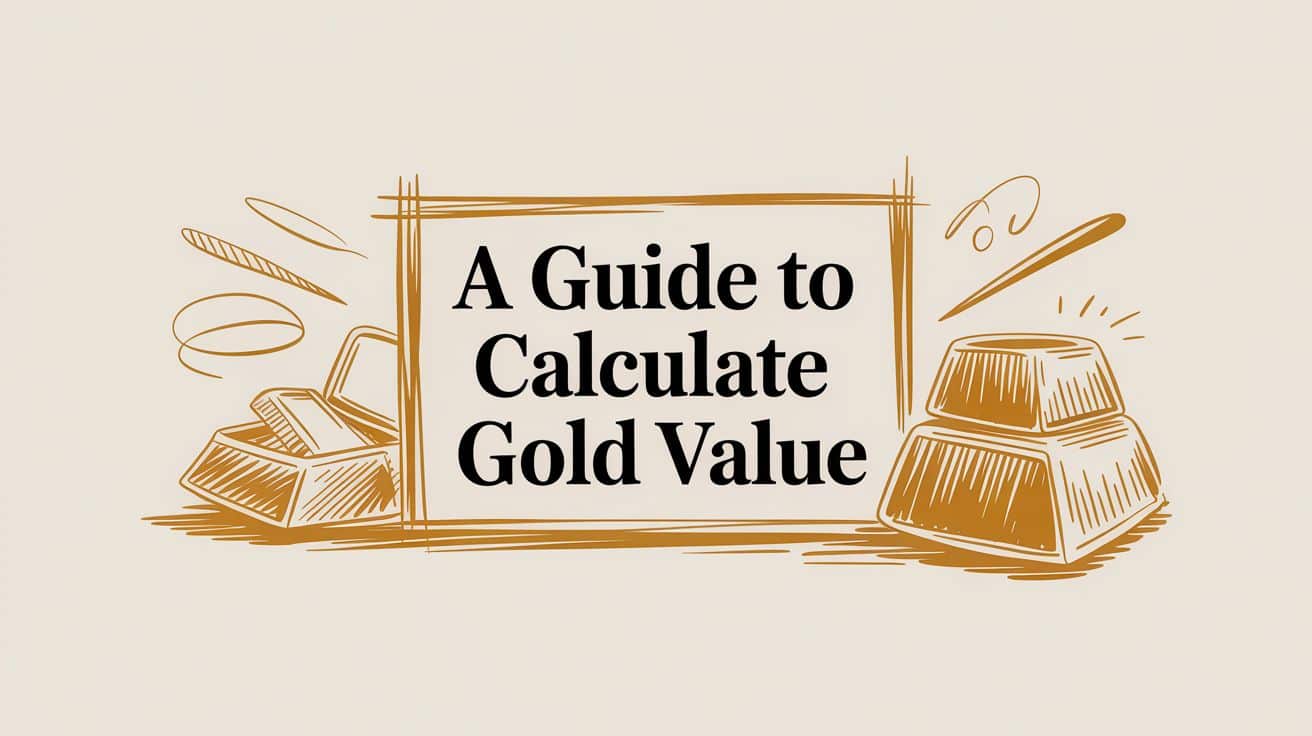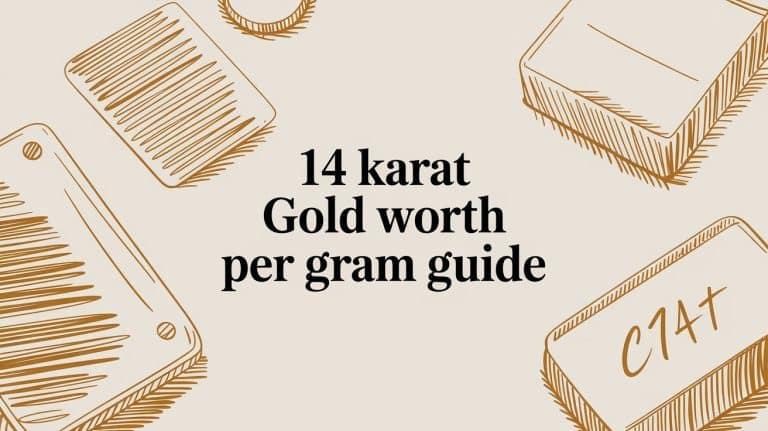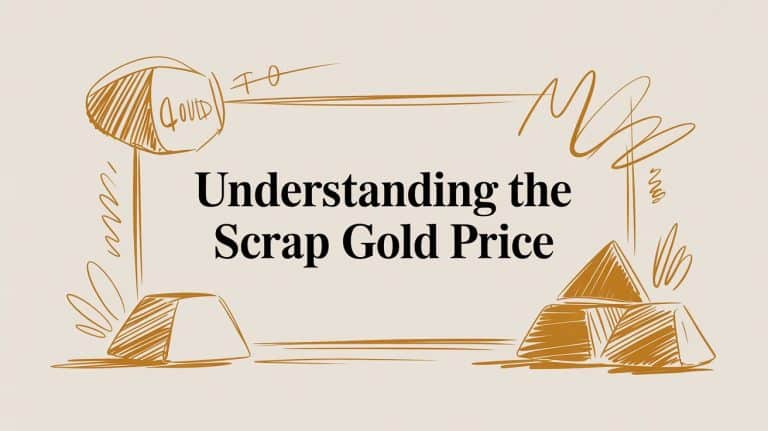An Essential Guide to Calculate Gold Value in 2026
Figuring out what your gold is worth might sound like a job for a pro, but it really just boils down to a few key details. Think of it like a simple recipe, get the ingredients right, and you will get an accurate result. Miss one, and the whole thing is off.
The entire process hinges on one simple goal: finding out how much pure gold is in your item and what that pure gold is worth on the market today. A 14k gold chain that weighs 10 grams is not actually 10 grams of pure gold; it is only 58.3% gold. Grasping that one concept is the most important part of the whole process.
The Three Pillars of a Gold Calculation
To get an accurate gold value, you will need to lock down three core pieces of information.
- Weight: First, you need the total mass of your gold item. Using a digital scale to measure in grams is the standard, and it is the most practical starting point for jewelry.
- Purity: Next is the percentage of actual gold in your item. This is where the karat marking comes in, like 18K or 22K, which tells you how much of the piece is pure gold versus other metals mixed in.
- Price: Finally, you need the live market value of gold, known as the “spot price.” This price is the global benchmark, and it moves all day, every day.
Insider Tip: Professionals almost always start by converting the spot price, which is usually quoted per troy ounce, into a price per gram. This makes it way easier to calculate the value of things like rings and chains, which are nearly always weighed in grams.
Once you have these three numbers, you have everything you need to do the math. But remember, they all work together. A heavier item is not automatically worth more than a lighter one if its purity is way lower. For instance, a small 22k gold earring could easily be more valuable than a big, chunky 10k bracelet.
This table gives you a clear look at how two very different items can stack up.
| Item Details | 10k Gold Bracelet | 22k Gold Earring |
|---|---|---|
| Total Weight | 20 grams | 8 grams |
| Gold Purity | 41.7% pure gold | 91.6% pure gold |
| Pure Gold Content | 8.34 grams | 7.33 grams |
See that? Even though it is much heavier, the 10k bracelet has only a tiny bit more pure gold than the 22k earring. Understanding this relationship between weight and purity is the key to estimating your gold’s real value. It makes sure you are valuing what actually matters, the precious metal itself, which is exactly what any buyer is going to do.
Decoding Gold Purity and Karats
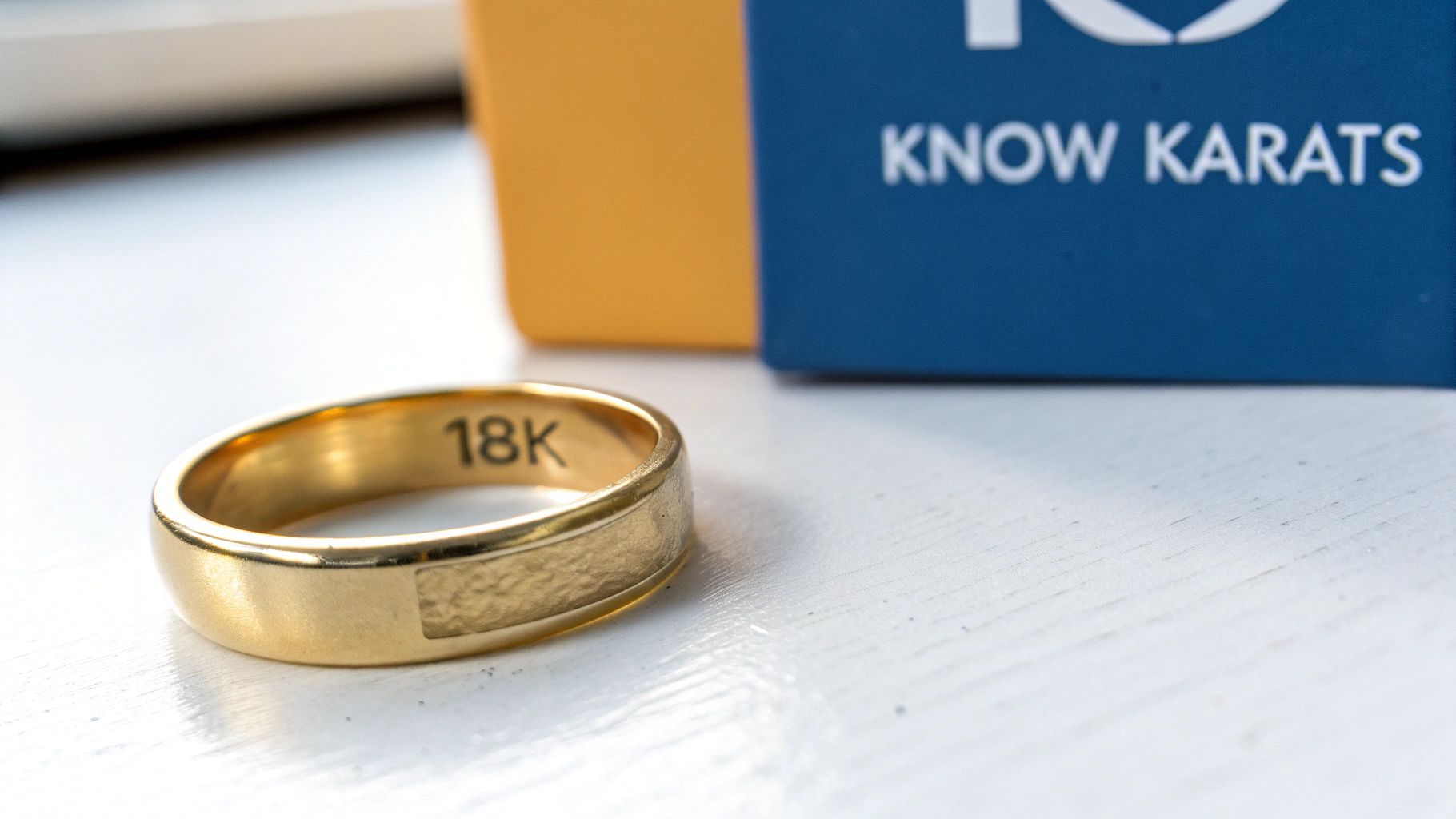
Before you can figure out what your gold is worth, you first need to understand that not all gold is created equal. That tiny ‘14k’ or ‘18k’ stamp you see on a clasp or inside a ring is the single most important clue to its real value.
This marking is the karat (K), which is simply a measurement of gold purity on a scale of 24 parts.
Pure, unadulterated gold is 24 karat (24k). But here is the thing, you almost never find jewelry made from 24k gold. It is incredibly soft, making it prone to dents and scratches with even light use. To make it strong enough for daily wear, gold is alloyed, or mixed, with more durable metals like copper, silver, or nickel. So, a lower karat number is not a bad thing; it is a sign of practical strength.
For example, a piece of jewelry stamped 18k is made of 18 parts pure gold and 6 parts other metals. Just do a little math (18 divided by 24), and you will find it is 75% pure gold. This detail is everything, because you are calculating the value of the actual gold content, not the item’s total weight.
Reading Hallmarks and Fineness Stamps
While the karat system (10k, 14k, 18k) is standard in the United States, many pieces from Europe and other parts of the world use a numerical system called millesimal fineness. This system measures purity in parts per thousand. It might sound complicated, but it is actually more direct.
A hallmark of ‘750’ means the item is 750 parts pure gold out of 1000. That is just another way of saying it is 75% pure, the exact same as 18k gold. It is an important distinction to know, as you might see a number instead of the familiar ‘K’ stamp.
Gold Karat Purity Conversion Chart
To make this simple, here’s a quick conversion table that connects the karat rating to its purity percentage and the most common fineness hallmark you’ll see stamped on a piece.
| Karat (K) | Gold Purity Percentage (%) | Fineness Hallmark |
|---|---|---|
| 24K | 99.9% | 999 |
| 22K | 91.6% | 916 |
| 18K | 75.0% | 750 |
| 14K | 58.3% | 583 |
| 10K | 41.7% | 417 |
Knowing this conversion is the first major step in accurately calculating your gold’s value, no matter where it was made.
Why Purity Is More Important Than Total Weight
It is a common mistake to assume a heavier gold chain is automatically worth more than a lighter one. But as we have seen, purity is the great equalizer. A heavy 10k gold bracelet might actually contain less pure gold than a delicate 22k earring.
Key Takeaway: The melt value of a gold item is based only on the weight of its pure gold content. The other metals in the alloy have negligible value in this context.
This is exactly why getting a handle on purity is so critical. It is the difference between a fair, realistic valuation and a wildly inaccurate, and often disappointing, one. A buyer will always base their offer on how much fine gold they can extract from your item after melting it down.
Of course, sometimes a hallmark is worn down or missing entirely. In those cases, you might need a more direct approach. If you are ever unsure, it is worth exploring our guide on how to test gold purity at home or through professional methods to get a definitive answer. Getting the purity right is the bedrock of your entire calculation.
How to Weigh Your Gold Accurately

Once you have got a handle on your gold’s purity, the next move is to find out its weight. Precision is everything here. Even a tiny mistake on the scale can throw off your final value by a surprising amount. The good news? You do not need any fancy lab equipment. A simple digital kitchen or jewelry scale will do the trick just fine.
The single most important feature your scale needs is the ability to measure in grams (g). This is the universal standard for weighing jewelry and scrap gold, so it is the perfect place to start any calculation. Before you weigh anything, just make sure your scale is on a flat, steady surface and tared, or zeroed out.
Getting the weight in grams gets you halfway home. But there is a catch: the official market price for gold, what we call the spot price, is almost always quoted in a different unit: the troy ounce (ozt). This is where a lot of people get tripped up, but do not worry, the conversion is simple once you know the numbers.
Grams, Troy Ounces, and Pennyweights Explained
It is natural to think an ounce is just an ounce, but that is not the case in the world of precious metals. The standard ounce you use for cooking is an avoirdupois ounce, which weighs 28.35 grams. A troy ounce, the unit used for gold, is heavier, coming in at 31.1 grams. That is a difference of nearly 10%, which is huge when you are calculating value.
Crucial Tip: Never use the standard ounce setting on your kitchen scale to calculate gold value. Always weigh in grams and then convert, or find the price per gram. Using the wrong ounce will give you a valuation that is significantly lower than it should be.
Another unit you might run into, especially in the US jewelry trade, is the pennyweight (dwt). It is a bit old school, but some pawn shops and jewelers still use it. One pennyweight is equal to 1.555 grams, and there are exactly 20 pennyweights in a single troy ounce.
Quick Conversion Reference Table
Keeping these units straight is much easier with a simple reference. Here is a handy table that shows how the most common units stack up against each other.
| Unit of Measurement | Equals (in Grams) | How Many in a Troy Ounce |
|---|---|---|
| Gram (g) | 1.0 g | 31.1 g |
| Troy Ounce (ozt) | 31.1 g | 1 ozt |
| Pennyweight (dwt) | 1.555 g | 20 dwt |
| Avoirdupois Ounce (oz) | 28.35 g | 1.097 oz |
As you can see, the distinction between a standard ounce and a troy ounce is absolutely critical. If you want to dig deeper, you can learn more about the differences between a gold troy ounce vs a regular ounce and why it matters so much.
Dealing with Gemstones and Non Gold Parts
So, what happens if your jewelry has diamonds or other stones set into it? This is a really common situation that just requires one extra step. Buyers are only interested in the weight of the gold, so the weight of any stones has to be subtracted.
For tiny accent stones, the weight is often so small it is considered negligible and will not really move the needle on the melt value. For anything larger, though, you have to account for it.
- A one carat diamond weighs exactly 0.2 grams.
- If you cannot pop the stones out yourself, a professional jeweler can estimate their weight and deduct it from the total.
- Do not forget that clasps, springs, and other non gold parts will also be discounted from the final weight.
By getting an accurate weight of only the precious metal, you ensure your valuation is based on what a buyer actually cares about. This methodical approach, weighing in grams, understanding the units, and accounting for non gold elements, sets you up perfectly for the next step: applying the live market price.
Finding and Using the Live Gold Spot Price
The value of gold is not set in stone; it is a living number, constantly shifting every few seconds with the pulse of global financial markets. This real time price is known as the gold spot price, and it is the universal benchmark for every single gold transaction, from massive billion dollar bullion trades right down to the gold ring on your finger.
To get an accurate valuation, you have to start with this live price. The spot price is almost always quoted per troy ounce. So, if you are trying to figure out what a 12 gram chain is worth, your first job is to find a reliable source for the spot price and then translate it into a unit that matches your item’s weight.
Where to Find a Reliable Spot Price
Finding the live price is the easy part. The key is to use a source that pulls data directly from major commodity exchanges like COMEX. Most major financial news sites, bullion dealer websites like APMEX or JM Bullion, and specialized commodity trackers all display the live spot price.
For our calculations, we will need the price per troy ounce. Once you have got that number, the next move is to convert it into a price per gram. This simple bit of math is what connects the global market price directly to the jewelry you are holding.
Converting the Spot Price to a Price Per Gram
Let us walk through the math. It is much simpler than it sounds.
A troy ounce contains 31.1 grams. That is the magic number. To find the price per gram, you just divide the spot price by 31.1.
Example Calculation:
- Let us say the live spot price of gold is $2,300 per troy ounce.
- The math is: $2,300 ÷ 31.1 = $73.95 per gram.
That result, $73.95, is your baseline value for one gram of pure, 24k gold at that exact moment. This figure is the foundation for everything else, especially for finding your item’s melt value, the raw, intrinsic worth of its gold content.
The gold market is famously sensitive to world events, which can cause dramatic price swings. For instance, in 2025, gold prices surged to historic highs, driven by geopolitical tensions and market volatility. By late October 2025, gold was trading around $4,020 per troy ounce, a jump of nearly 47% from the previous year. You can find more insights on these trends in J.P. Morgan’s commodity research. This rally shows just how quickly the value of your gold can change, making it essential to use the most current price available.
Why Melt Value Is the Starting Point for Buyers
When you use the price per gram and your item’s purity to calculate its value, you are finding its melt value. This is the fundamental number every buyer, from a local jeweler to a massive refiner, uses as their starting point.
Key Insight: Melt value represents the raw material worth of your gold. It completely ignores things like craftsmanship, brand names, or artistic design because the buyer assumes the item will be melted down and the pure gold extracted.
Getting a handle on this step is incredibly empowering. It gives you a clear, data driven understanding of what your gold is worth on the open market before you even talk to a buyer. You will walk in knowing the true market value, which puts you in a much stronger position.
Here’s a simple table showing how the price per gram moves with the spot price.
| Live Spot Price (per Troy Ounce) | Price Per Gram (Spot Price ÷ 31.1) |
|---|---|
| $2,200 | $70.74 |
| $2,300 | $73.95 |
| $2,400 | $77.17 |
| $2,500 | $80.38 |
As you can see, even a $100 move in the spot price shifts the per gram value by several dollars. This is why using a real time price is not just a suggestion, it is a requirement for getting your numbers right.
Putting It All Together with Real Examples
Theory is great, but seeing the numbers in action is where it all clicks. Let us walk through a few practical, real world examples to show you exactly how to calculate gold value from start to finish. We will use the same simple formula every time to build your confidence and make the process feel second nature.
The core formula never changes: Weight x Purity Percentage x Price per Gram = Value.
This equation is your best friend. Once you understand how to find each of the three key components, you can accurately figure out the melt value of pretty much any gold item you come across.
Example 1: The 14k Gold Chain in US Dollars
Let’s start with an item we have all seen: a 14 karat gold chain. Imagine you pop it on a digital scale and it weighs exactly 15 grams.
Your first step is to figure out the purity. As we know, 14k gold is not pure; it is 58.3% pure gold (that is 14 divided by 24). The rest is just alloy metals that add strength and durability.
Next, you need the live gold spot price. For this example, let us say the current price is $2,350 per troy ounce. But since our chain is in grams, we need to convert the price to match.
- Price per Gram Calculation: $2,350 (spot price) ÷ 31.1 (grams in a troy ounce) = $75.56 per gram
Now you have all three pieces of the puzzle. Just plug them into the formula to find the melt value of your chain.
- Final Calculation: 15 grams (Weight) x 0.583 (Purity) x $75.56 (Price per Gram) = $660.29
So, the raw melt value of your 15 gram, 14k gold chain is $660.29 USD at this specific moment. This is the baseline number a buyer would start with before factoring in their own fees.
A common mistake is forgetting to convert the purity percentage into a decimal for the calculation. Always remember to move the decimal point two places to the left, so 58.3% becomes 0.583.
Example 2: The 22k Gold Coin in British Pounds
Now let us switch things up with a different item, purity, and currency to show how the principles stay exactly the same. Consider a 22 karat gold coin, like a British Sovereign, which weighs a standard 8 grams.
First, the purity. A 22k coin is significantly purer than 14k jewelry. Its purity is 91.6% pure gold (22 divided by 24).
Next, we need the gold spot price, but this time in British Pounds. Let us assume the live price is £1,860 per troy ounce. We will do the same conversion to find our price per gram.
- Price per Gram Calculation: £1,860 (spot price) ÷ 31.1 (grams in a troy ounce) = £59.81 per gram
With the weight, purity, and price per gram ready, we just apply the formula again.
- Final Calculation: 8 grams (Weight) x 0.916 (Purity) x £59.81 (Price per Gram) = £438.30
The melt value of this 8 gram, 22k coin is £438.30 GBP. As you can see, even with different units and currencies, the process is identical.
Comparing Different Items and Units
The real power of this formula is its versatility. It works whether you are weighing a tiny earring or a heavy bar, using grams or pennyweights, in dollars or euros. To illustrate, let us put two hypothetical items side by side to see how weight and purity interact to create the final value.
| Item Details | 10k Gold Ring | 18k Gold Bracelet |
|---|---|---|
| Total Weight | 12 grams (or 7.72 dwt) | 9 grams (or 5.79 dwt) |
| Gold Purity | 41.7% (0.417) | 75.0% (0.750) |
| Pure Gold Content | 5.00 grams | 6.75 grams |
| Spot Price (USD) | $2,350 per troy ounce | $2,350 per troy ounce |
| Price per Gram | $75.56 | $75.56 |
| Calculated Melt Value | $377.80 | $510.03 |
This table clearly shows why you cannot judge an item’s value on weight alone. The 18k bracelet, despite being 25% lighter than the 10k ring, has a significantly higher melt value. Its superior purity means it contains more actual gold, and at the end of the day, that is what truly drives the price.
Mastering these hands on scenarios is the key to confidently valuing any gold you have.
From Melt Value to a Fair Cash Offer
Alright, so you have worked through the numbers and have a solid grasp of your gold’s melt value. That figure is the pure, intrinsic worth of the gold in your item, and it is your most important tool. But it is crucial to understand that this is the starting point, not the final cash offer you will get from a buyer.
One of the most common questions I hear is, “If my gold is worth $700, why am I only being offered $550?” It is a fair question, and the answer comes down to the simple realities of the precious metals business. Jewelers, pawn shops, and refiners are businesses with real world overhead. The gap between the melt value and their offer covers everything it takes to turn your old jewelry back into pure gold.
This infographic breaks down the core process every buyer uses to get to that initial melt value.
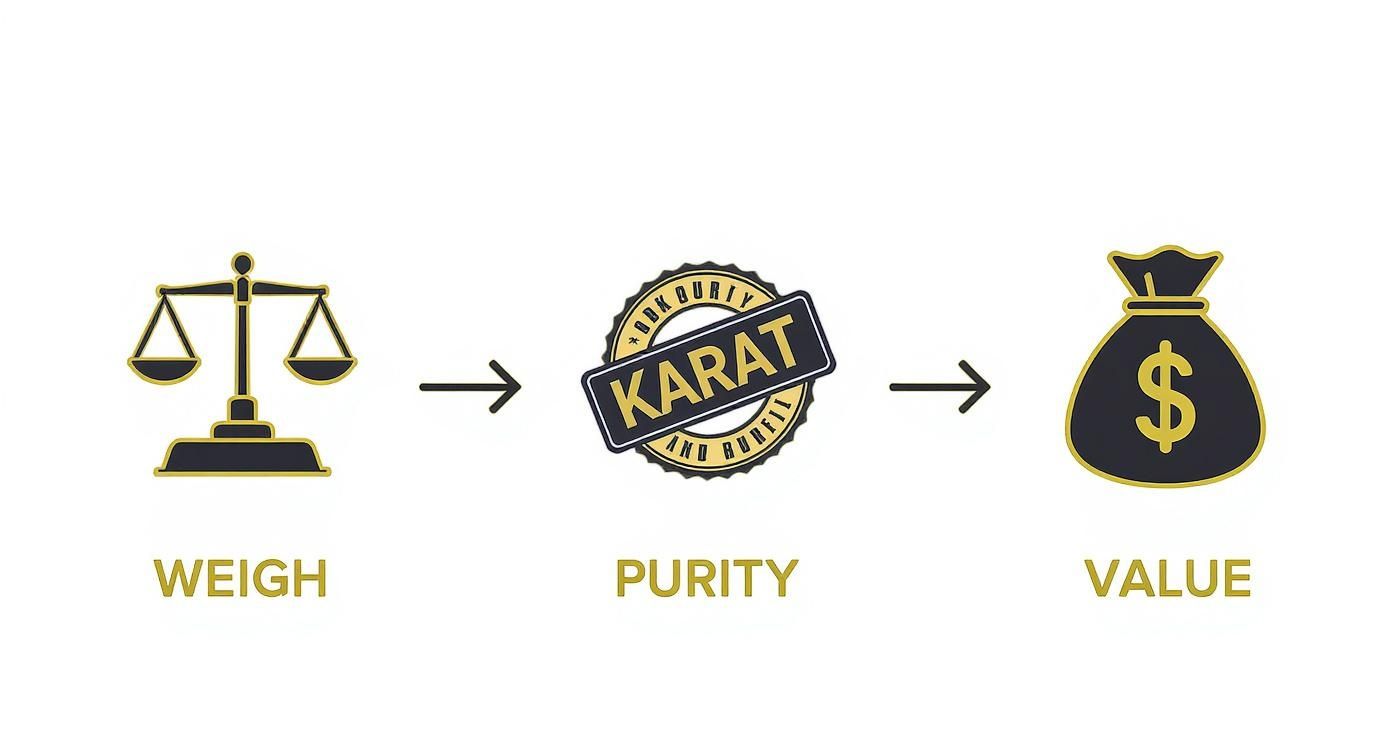
From weighing your item to verifying its purity and running the numbers against the live market price, this is the universal standard.
Why Buyers Pay a Percentage of the Spot Price
When a business buys your gold, they take on several costs and risks before they ever see a profit. The payout percentage they offer you directly reflects these operational factors.
- Refining Costs: Your scrap gold is not pure. It has to be melted down and professionally refined to separate the 24k gold from the other metal alloys. This is an industrial process, and it comes with fees.
- Testing and Verification: Before a buyer can even make an offer, they have to be sure of what they are buying. This means using an acid test or, more commonly these days, a sophisticated XRF (X ray fluorescence) scanner for a precise reading. Those tools are not cheap.
- Market Volatility: The spot price of gold can swing up or down in a matter of minutes. The buyer shoulders the risk that the price could drop between the moment they buy your gold and the time they sell it to a major refiner.
- Operational Overhead: Just like any other shop on Main Street, a gold buyer has rent, employee salaries, security, insurance, and other bills to pay. All of this is factored into their buying price.
Key Takeaway: A buyer’s offer is the melt value minus their costs and a reasonable profit margin. Expecting 100% of the spot price for scrap gold is unrealistic, it would mean the buyer is operating at a loss.
What Is a Fair Payout Percentage?
So, what is a fair shake? Generally speaking, a reputable buyer will pay somewhere between 70% and 95% of your item’s melt value. Where your offer lands in that range depends on a few key things.
Knowing what drives these percentages is what gives you the power to negotiate. For a deeper dive, our guide to current scrap gold prices offers more insight into what to expect in today’s market. A big pile of high purity gold will always get you a better percentage than a single, low karat ring.
Factors That Influence Your Offer
Not all gold is treated equally by buyers, and the percentage you are offered can shift based on the specifics of what you are selling. Here’s a quick look at what can push an offer up or down.
| Factor | Lower Payout (Closer to 70%) | Higher Payout (Closer to 95%) |
|---|---|---|
| Quantity | Selling a single, lightweight item (e.g., one 10k ring) | Selling a large quantity of gold by weight |
| Purity | Lower karat items like 10k or 14k gold | High purity items like 22k or 24k gold bullion |
| Buyer’s Business Model | Pawn shops with high overhead and varied inventory | Specialized online refiners with lower operational costs |
| Reputation & Volume | Small, local shops with lower transaction volume | Large, high volume dealers with established partners |
By understanding these dynamics, you can walk in with confidence. You are now equipped not just to calculate your gold’s value, but to understand what a fair cash payment truly looks like. Try our free gold calculator today.


